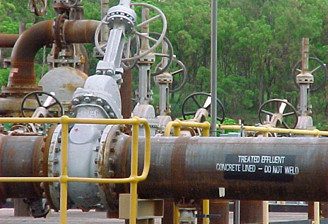QAL and Gladstone Regional Council (GRC) have a long-term, sustainable partnership to achieve significant environmental, community and economic benefits regarding water use. In a unique project, secondary treated effluent from Gladstone City’s sewage treatment plants is sent to QAL, for use in the final wash process of the alumina refining process. Not only has this significantly reduced the use of fresh water by industry, saving valuable megalitres from the region’s precious water reserves, but it has also realised significant environmental benefits, eliminating the discharge of secondary treated effluent into the Calliope River estuary and the Gladstone Harbour, thus protecting the coastal environment for the future.
When it was commissioned in November 2002, the Treated Effluent Reuse Scheme was a unique initiative where all the secondary treated effluent from GRC’s Calliope River Sewerage Treatment Plant was pumped to QAL for use in the final wash process of the alumina refining process. Although QAL and GRC had been discussing the possibility of using treated effluent for some time, the effluent reuse scheme became a reality at that time due to the introduction of water restrictions as part of the region’s drought management strategy.
With the declaration of drought in April 2002, the Gladstone Area Water Board introduced water restrictions to the Gladstone Region for the first time in 30 years. Initially a 10% reduction was imposed on industrial users and 35% on local government users. Following further water level drops in the region’s fresh water reservoir, Awoonga Dam, industry restrictions increased to 25% and the residential and commercial users to 50% in November 2002.
When the project was originally proposed in 2000, the scheme was largely dependent on being eligible for subsidies from the State Government for effluent reuse. The declaration of drought and introduction of water restrictions raised the sense of urgency for the project, so QAL decided to proceed with the effluent reuse scheme in partnership with Council, independent of any State Government assistance.
A Memorandum of Understanding between Gladstone City Council and QAL was signed in July 2002. The project involved the construction of on-site storage lagoons, a pumping station and a chlorination plant at the Calliope River Sewerage Treatment Plant, 8.5 kms of pipeline through the city to QAL’s Parsons Point alumina refinery and receival works at the plant. Upon completion of the pipeline across the city, the disturbed areas were covered with a mulch product, to avoid erosion and silt movement into the local waterways. This mulch was generated from shredded household and commercial green waste recycled at the Gladstone Waste Management Centre.
The project was commissioned on 7 November 2002 and was $0.9 million under total estimated cost.
In February 2015 QAL began receiving secondary treated effluent from an additional GRC sewage treatment plant at Boyne Island and Tannum Sands. The treated effluent QAL now receives is the equivalent of 23% of the raw water in the Awoonga Dam reservoir.
With this cooperative approach, the water saving challenge was quickly met, and exceeded all expectations. The treated effluent reuse scheme is an excellent example of how a partnership approach can achieve and deliver significant short and long-term benefits to the partners, community and the environment.
